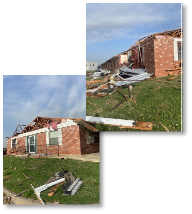Oklahoma Health Care Coalition Coordinates with Key Response Partners to Relocate Nursing Home Patients After Central Oklahoma Tornadoes
Oklahoma
April 2023
Impact
The Region 6/8 – Regional Medical Response System (RMRS), the lead agency for one of Oklahoma's six health care coalitions (HCCs), coordinated a timely and successful near twenty-four-hour long response to the 18 tornadoes that hit central Oklahoma on April 19, 2023. The HCC coordinated with nearby hospitals, local emergency medical services (EMS), public health, and long-term care facilities to relocate 79 nursing home residents within just three hours after a tornado destroyed their facility. The Region 6/8 RMRS used lessons learned from previous disaster responses and trainings, in addition to calling upon key relationships with their health care and emergency partner networks to respond quickly and effectively.
|
“This situation shows the value of being a coalition that works together, plans together,
and understands how a response will work. Having the opportunity to not only practice a response
during an exercise, but practically apply it to real world scenarios, has added incredible value to
our coalition and to our Region.”
- Zakia Yazdanipour
Director of the Region 6/8- Regional Medical Response System
|
Background
Throughout the morning and afternoon of April 19, 2023, the Region 6/8 - RMRS was monitoring the events surrounding the 28th memorial anniversary of the Oklahoma City bombing. At the same time, HCC members were in constant communication with their partners at the National Weather Services office in Norman, OK, tracking the incoming severe weather that was expected to hit the area later that day. Around 6:00 PM, thunderstorms and severe weather began in Cleveland and South Oklahoma counties. These storms quickly formed tornados, bringing wind, hail, rain, and other severe weather along in their path. Before the storms had even hit, the Region 6/8 RMRS began coordination efforts that would eventually lead to a successful, timely, and effective response.
Response:

Throughout the afternoon, the Region 6/8 - RMRS began contacting long term care facilities and hospitals in the tornadoes’ path. The HCC’s leadership team also contacted nearby hospitals, local EMS, and public health, assembling a response team in preparation for the destruction. As the evening progressed into the night, 18 tornadoes touched down, including two tornadoes with EF3 intensity and four with EF2 intensity. Once the storms had passed, the Region 6/8 - RMRS team sprang into action, simultaneously contacting teams on the ground that were assessing damage, reaching out to health care facilities in the affected areas as the coalition worked to identify needs, and coordinating a prompt response between all emergency and health care partners. After making direct contact with each facility in the tornadoes’ path, the HCC identified two facilities that had sustained damage: one hospital which did not require evacuation, and one nursing home facility that required an immediate evacuation and relocation of its 79 residents. Throughout the storm, the nursing home facility was able to keep all residents safe and calm, moving them to safe spots throughout the facility, and keeping them in good spirits by playing games as they waited for the storms to pass. As a result, not a single resident sustained injuries.
Once the storms had passed, the Region 6/8 - RMRS team immediately began a multi-faceted effort to respond to the damage at the nursing home facility. The HCC worked with EMS, public health, and other partners including a local school where the Vice Principal volunteered to drive a school bus to transport patients from the nursing home nearly two hours away to a new, safe location. Within just three hours, the Region 6/8 - RMRS coordination team had secured placements for all 79 residents, thanks to help from neighboring HCCs and long-term care facilities.

